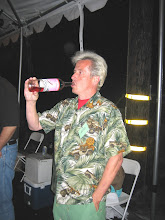The recent reputational suicide of the critic Robert Parker, known for his love of high-extract, high-alcohol wines, has freed some of us to produce in this style without opening ourselves to charges of pandering to the Noseless Emperor, and I am one of those - though unlike Mr. Parker I didn't spend my college years dropping candy bars into tumblers of Everclear and slamming them down at parties. During my New Mexico enological sideshow in the '90's, I made a few wines under 12% in alcohol, as it seemed what the variety, chemistry, and ripeness required, and most of my best California wines of the last century (!) were under 14% ABV, though primarily Chardonnay and Pinot Noir.
Upon devoting my overtime oenological energies to California (I'd never stopped making wine here; our New Mexico harvests were in July leaving me free to return west in mid-August) and more importantly, moving to the Central Coast, I noticed that Syrah in particular often did not flavor-ripen until higher potential alcohols were reached, and in the case of the west Paso hills and mountains, the best examples were often over 16%. (Saxum is perhaps the prime example; I can say I was present at their creation while claiming no credit.) The La Mort Du Roi and Colossus wines, which have ranged from 16.1 to 17.5, have I think been in the same league, or ballpark to abuse the metaphor.
The percentage of alcohol by volume is usually the only scientifically derived number on a bottle of wine, and thus offers an easily misunderstood measure of its other features. The pretentions to expertise of wine writers being what they are, ignorant opinionation on the subject has multiplied like yeast cells in rich must over the last decades, and show no signs of stopping, though some of us smelled the off aromas of bad fermentation a long time ago.
"As is well known" the alcohol in the bottle is the result of the sugar in the grapes; without intervention the conversion rate is in the .55-.62 range, and so by reading the number on a label we can deduce a general idea of the ripeness of the grapes at harvest, remembering that Buellton is not Barstow nor Sonoma Sacramento, and of course accounting for the variety. The complicating factors make assumptions unreliable, to say the least: in wine as in so many other things, exceptio probat regulam: the exception probes the rule, puts it to the test, it does not prove or confirm it. (A different kind of 'proof' though related.) So to the anti-high-alcohol pontificators, let me offer the following:
If you're getting too buzzed from a glass or three of 16% alcohol wine, drink a bit less or add an ice cube. I won't judge you - much.
Some high-alcohol wines are 'flabby' - low in acid, low in tannin if red, and/or low in C02. That's not because of the alcohol. (Repeat.) This goes for other faults as well, all of which can be found in lower alcohol wines. Balance between structural elements is complex!
High alcohol wines aren't food-friendly? Who has a huge Shiraz with trout? Would you have a dry Rose of Grenache with a BBQ glazed tri-tip? If your sommelier suggested those pairings, he's just a busboy who won't shut the fuck up.
UPDATE: Several hours after writing this, one of my wines won a 'shootout' tasting at a swanky event in Solvang (Santa Ynez Valley, Santa Barbara) - over two dozen winemakers were asked to bring their 'best' wines, which were then tasted blind with each judge - the aforementioned winemakers, for the most part - being asked to vote for one wine. The winning wine was 17.5% alcohol, and the vote wasn't close. (It was a fraternal twin sister of the Colossus under one of my client's labels, different barrels being the only distinction.)






